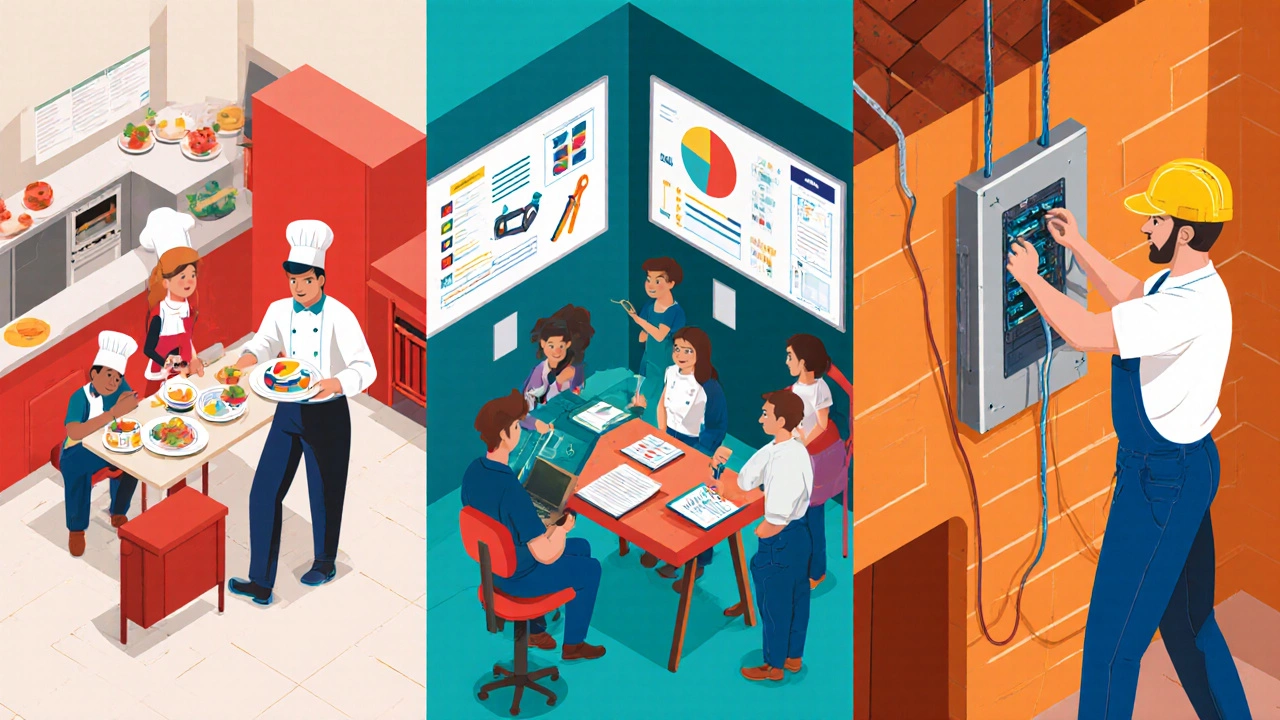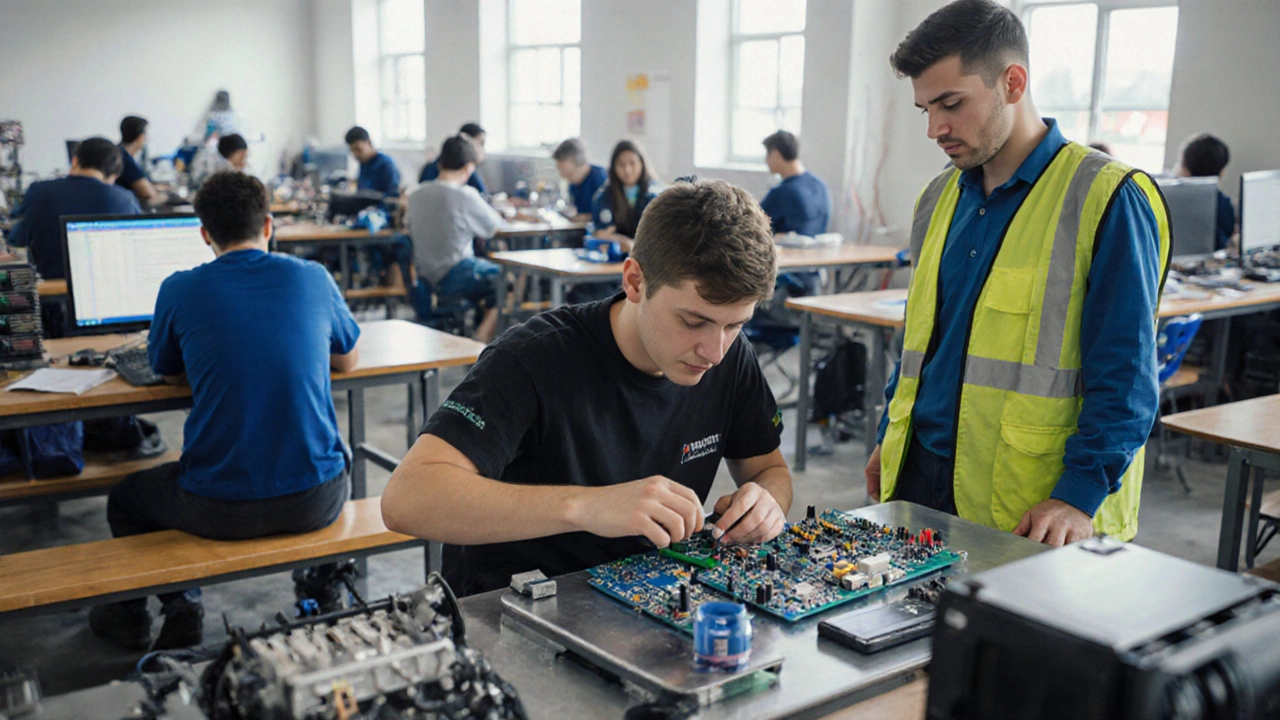Vocational Course Comparison Tool
Certificate Programs
Focused on foundational skills for an occupation. Typically lasts 6-12 months.
Duration: 6-12 monthsDiploma Programs
More in-depth courses covering technical abilities and workplace communication. Usually takes 1-2 years.
Duration: 1-2 yearsApprenticeships
Blend of on-the-job training and classroom study. Typically spans 3-4 years.
Duration: 3-4 yearsMicro-Credentials
Short workshops focusing on a single skill. Ideal for upskilling or career transitions.
Duration: Weeks to MonthsComparison Table
| Aspect | Certificate | Diploma | Apprenticeship | Micro-Credential |
|---|---|---|---|---|
| Duration | 6-12 months | 1-2 years | 3-4 years | Weeks to months |
| Focus | Foundational job skills | Technical + communication | On-the-job + classroom | Single specialized skill |
| Entry Requirement | High school diploma | High school diploma | High school diploma | High school diploma |
| Credential | Certificate | Diploma | Apprenticeship Qualification | Certification or Badge |
| Employment Outlook | Direct pathway to entry-level roles | Broader career options | Industry recognized qualification | Specialized skill enhancement |
Key Insight
Vocational courses are designed for speed-to-employment and job-readiness. They offer a direct pathway to specific trades or roles, making them ideal for those seeking quick career entry.
People often wonder what a vocational course actually is and whether it fits their career goals. In simple terms, a vocational course is a structured learning program that focuses on practical skills needed for a specific job or industry. Unlike traditional academic routes that emphasize theory, vocational courses aim to get you job-ready as quickly as possible.
What Is a Vocational Course?
When we talk about a Vocational Course is a short‑to‑medium length program designed to teach job‑specific skills, usually leading to a recognized credential. These programs are part of the broader Technical and Vocational Education and Training (TVET) ecosystem, which blends classroom instruction with hands‑on practice.
TVET is overseen by government bodies, industry groups, and educational institutions to ensure that the training matches real‑world demand. In Australia, the Australian Skills Quality Authority (ASQA) accredits most vocational providers to guarantee quality and relevance.
Common Types of Vocational Courses
Vocational training comes in several shapes, each catering to different learning needs and career paths.
- Certificate programs that usually last 6‑12 months and focus on foundational skills for an occupation.
- Diploma more in‑depth courses ranging from 1‑2 years, often covering both technical abilities and workplace communication.
- Apprenticeship a blend of on‑the‑job training and classroom study, typically spanning 3‑4 years and leading to a nationally recognised qualification.
- Short workshops or micro‑credentials that focus on a single skill, such as advanced Excel, CNC machining, or digital marketing.
Each type is linked to an Industry Partner a company or trade association that helps shape the curriculum and often provides placement opportunities. This partnership ensures that the course content stays current with industry standards.
Vocational Courses vs. Academic Degrees
Many prospective students compare vocational courses with traditional university degrees. Below is a quick side‑by‑side look.
| Aspect | Vocational Course | Academic Degree |
|---|---|---|
| Duration | 6 months - 2 years | 3 - 4 years (undergraduate) |
| Focus | Practical, job‑specific skills | Theoretical foundation + research |
| Entry Requirements | High school diploma or equivalent | High school diploma + GPA/standardized tests |
| Cost (average in Australia) | $2,000 - $15,000 total | $20,000 - $40,000 per year |
| Credential | Certificate, Diploma, or Apprenticeship qualification | Bachelor’s, Master’s, or Doctorate degree |
| Employment Outlook | Direct pathway to specific trades or roles | Broader career options, may require further specialization |
While degrees offer a wider academic perspective, vocational courses are designed for speed-to-employment. If your goal is to start earning in a skilled trade within a year, a vocational route often makes more sense.

The Benefits of Enrolling in Vocational Courses
Here are the main advantages that learners regularly cite:
- Job‑Readiness: Programs are built around an Occupational Standard a government‑approved set of tasks and competencies for a specific role, so graduates meet employer expectations.
- Cost‑Effectiveness: Shorter duration means lower tuition and quicker return on investment.
- Flexibility: Many providers offer part‑time, online, or blended delivery, allowing you to study while working.
- Industry Connections: Through Industry Partners, students often access internships, apprenticeships, or guaranteed interview pipelines.
- Pathways to Further Study: Credits from a diploma can often be transferred into a related bachelor’s program, giving you options to upskill later.
How Vocational Courses Are Structured
Modern vocational training relies heavily on Competency‑Based Training a learning model where progress is measured by demonstrated ability rather than time spent. This approach aligns with the Skills Framework a national guide that maps out the skill levels needed for each occupation. Learners complete assessments that prove they can perform real‑world tasks, which employers trust.
For example, a Certificate IV in Hospitality might require you to successfully run a simulated restaurant service, while a Diploma in Cyber Security demands you to configure firewalls and respond to mock breaches.
Choosing the Right Vocational Course for You
Not every course fits every person. Use these criteria to narrow down your options:
- Industry Demand: Check the Australian government's Job Outlook website for growth projections in the field you’re eyeing.
- Accreditation: Ensure the provider is registered with ASQA and that the course leads to a nationally recognised Credential.
- Delivery Mode: Do you need in‑person labs (e.g., automotive mechanics) or can you learn fully online (e.g., digital marketing)?
- Pathway Options: Some diplomas offer credit toward a bachelor’s degree; if you might want that later, choose a pathway‑friendly program.
- Cost & Financial Aid: Look for government subsidies like the VET Student Loans scheme, especially for eligible courses.
Once you have a shortlist, reach out to the Industry Partner listed on the course page. Ask about recent graduate outcomes, placement rates, and whether they host on‑site workshops.

Real‑World Examples of Vocational Success
Consider Sarah, a Melbourne resident who completed a Certificate III in Electrical Installation. Within six months, she landed a junior electrician role at a local contractor, earning $65,000 per year. The hands‑on labs and an apprenticeship placement secured through the course’s industry partner made the transition seamless.
Or James, who pursued a Diploma in Graphic Design. His final project-an actual branding package for a Melbourne café-caught the eye of the café’s owner, who hired James as a freelance designer. The portfolio piece directly led to paid work.
These stories illustrate how a well‑chosen vocational course can fast‑track you into a rewarding career.
Future Trends in Vocational Education
Technology is reshaping how skills are taught. Look out for these developments:
- Virtual Reality (VR) Labs: Trade schools are using VR to simulate hazardous environments like welding or heavy‑machinery operation without real‑world risk.
- Micro‑Credentials: Badges for narrow skill sets (e.g., Python for Data Analysis) are stacking up to form a full qualification.
- Industry‑Led Curriculum Updates: Rapidly changing sectors-like renewable energy-are pushing providers to refresh modules every six months.
Staying aware of these trends helps you pick a program that won’t become outdated before you graduate.
Frequently Asked Questions
What is the typical duration of a vocational course?
Most certificates run 6‑12 months, diplomas last 1‑2 years, and apprenticeships can take 3‑4 years, depending on the trade.
Do vocational courses lead to nationally recognised qualifications?
Yes. Courses accredited by ASQA award qualifications that are listed on the Australian Qualifications Framework (AQF).
Can I get financial support for a vocational course?
Eligible students can apply for VET Student Loans, state‑based subsidies, or employer‑sponsored training funds.
How do vocational courses differ from online MOOCs?
MOOCs often lack formal accreditation and hands‑on components, whereas vocational courses provide a recognized credential and industry‑aligned practical training.
Is it possible to transition from a vocational qualification to a university degree?
Many universities accept credit transfers from diplomas, letting you enter directly into the second or third year of a related bachelor’s program.

